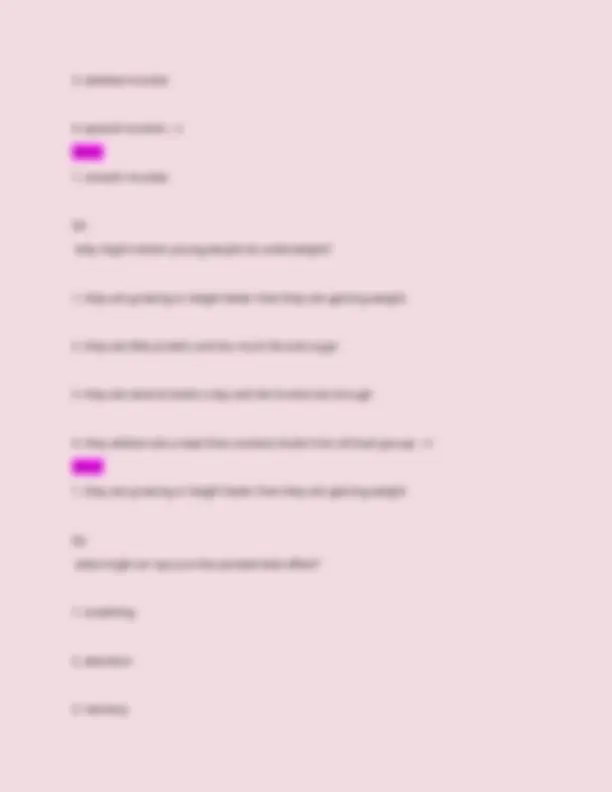






























































































Study with the several resources on Docsity

Earn points by helping other students or get them with a premium plan


Prepare for your exams
Study with the several resources on Docsity

Earn points to download
Earn points by helping other students or get them with a premium plan
Community
Ask the community for help and clear up your study doubts
Discover the best universities in your country according to Docsity users
Free resources
Download our free guides on studying techniques, anxiety management strategies, and thesis advice from Docsity tutors
Elsevier Hesi A2 A&P Practice exam Questions and answers with verified answers. Qs In which of the following locations would the urinary bladder and internal reproductive organs be found? 1. Thoracic cavity 2. Mediastinum 3. Abdominal cavity 4. Pelvic cavity - n Ans✔ 4. Pelvic cavity Qs Which tissue serves as the framework of the body by providing support and structure for the organs? 1. Epithelial 2. Connective 3. Nervous 4. Muscle - n Ans✔ 2. Connective Qs What are the glands of skin that produce a thin, watery secretion? 1. Sebaceous glands 2. Eccrine glands 3. Apocrine glands 4. Endocrine glands - n Ans✔ 2. Eccrine glands Qs You have been given a sample of tissue that has open spaces partially filled by an assemblage of needle-like structures. What is the tissue?
Typology: Exams
1 / 216

This page cannot be seen from the preview
Don't miss anything!





























































































Qs In which of the following locations would the urinary bladder and internal reproductive organs be found?
Mediastinum
Abdominal cavity
Pelvic cavity - n Ans✔
Pelvic cavity Qs Which tissue serves as the framework of the body by providing support and structure for the organs?
Epithelial
Connective
Nervous
Muscle - n Ans✔
Connective Qs What are the glands of skin that produce a thin, watery secretion?
Sebaceous glands
Eccrine glands
Apocrine glands
Qs Which mineral is responsible for regulating fluid in the body?
Chloride
Sodium
Calcium
Magnesium - n Ans✔
Sodium Qs All actions of the nervous system depend on the transmission of nerve impulses over which of the following?
Neuroglia
Efferent pathways
Afferent pathways
Neurons - n Ans✔
Neurons Qs Which leukocytes are correctly matched with their function or description? (Select all that apply.)
Monocytes—become macrophages
Basophils—the most common type of WBC
Lymphocytes—important in immune response
Contraction of the diaphragm, which decreases the volume of the chest cavity and draws air into the lungs
Contraction of the diaphragm, which enlarges the chest cavity and draws air into the lungs
Recoil of the lungs as the respiratory muscles contract and the thorax decreases in size
Recoil of the lungs as the respiratory muscles relax and the thorax decreases in size - n Ans✔
Contraction of the diaphragm, which enlarges the chest cavity and draws air into the lungs Qs Which are the functional units of the kidney?
Ureters
Glomeruli
Nephrons
Renal capsules - n Ans✔
Nephrons Qs What separates the thoracic cavity from the abdominal cavity?
Diaphragm
Mediastinum
Liver
Lungs - n Ans✔
Diaphragm
Hemopoiesis
Conduct impulses
Provide protection - n Ans✔ 1, 2, and 4 Qs Why are skeletal muscles also called voluntary muscles?
They are under conscious control.
They are attached to the skeleton.
They use ATP to energize contraction.
They are striated in appearance. - n Ans✔
They are under conscious control. Qs Motor or ____________ neurons transmit nerve impulses away from the CNS.
afferent
efferent
central
peripheral - n Ans✔
efferent Qs What are chemical messengers that control growth, differentiation, and the metabolism of specific target cells called?
Inhalation
Cellular respiration - n Ans✔
External respiration Qs Most of the carbon dioxide in the blood does which of the following?
It is carried in solution or bound to blood proteins.
It is carried on hemoglobin.
It is converted to bicarbonate ions by carbonic anhydrase within red blood cells.
It is converted to bicarbonate ions by carbonic anhydrase within the plasma. - n Ans✔
It is converted to bicarbonate ions by carbonic anhydrase within red blood cells.
Qs The stomach muscle churns and mixes food, turning the mass into a soupy substance called which of the following?
Bolus
Bile
Chyme
Feces - n Ans✔
Chyme Qs What are the two functions of the male and female sex organs?
Production of all cells and production of hormones
If you wanted to separate the abdominal cavity from the thoracic cavity, which plane would you use?
Qs the epidermis is classified as an: